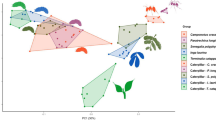Abstract
Adult pale morphs of an aphidophagous lady beetle, Propylea dissecta (Mulsant) (Coleoptera: Coccinellidae), were reared on a non-insect diet for periods ranging from 0 to 30 days after eclosion. The prey-deprived females, when provided with the cowpea aphid, Aphis craccivora Koch (Homoptera: Aphididae), laid fertile eggs, indicating that they had retained their reproductive potential. The oviposition period, post-oviposition period, fecundity, viability of eggs and longevity of females decreased significantly, whereas the pre-oviposition period and developmental period of progeny increased significantly with an increase in the duration of prey deprivation. There was no significant effect on the mean reproductive rate (16.14 ± 0.53 to 18.03 ± 0.67 eggs per day) at various prey deprivation levels, although the reproductive output and oviposition duration decreased. These findings indicate that lady beetle females can withstand the stress of prey non-availability, by switching to alternative food sources and reproducing when essential prey becomes available again.
Résumé
Les formes claires de l’adulte de la coccinelle aphidiphage, Propylea dissecta (Mulsant) (Coleoptera: Coccinellidae), ont été élevées sur un milieu dépourvu d’insectes pendant une période comprise entre 0 et 30 jours après leur émergence. Lorsque les femelles ainsi privées de proies ont été placées en présence de puceron du niébé Aphis craccivora Koch (Homoptera: Aphididae), elles ont pondu des oeufs fertiles, indiquant qu’elles ont conservé leur potentiel reproducteur. La période ovipositionnelle, la période post-ovipositionnelle, la fécondité, la viabilité des oeufs et la longévité des femelles diminuent significativement alors que la période pré-ovipositionnelle et la durée de développement des larves augmentent significativement avec l’augmentation de la durée de privation en proies. Il n’y a pas d’effet significatif sur le taux moyen de reproduction (compris entre 16,14 ± 0,53 et 18,03 ± 0,67 oeufs par jour) pour les différents niveaux de privation de proies, bien que le rendement reproductif et la durée d’oviposition diminuent. Ces résultats indiquent que les femelles coccinelles peuvent endurer une période de privation de proies, en s’adaptant à une source de nourriture alternative et en se reproduisant quand les proies essentielles sont à nouveau disponibles.
Similar content being viewed by others
References
Babu A. (1999) Influence of prey species on feeding preference, post embryonic development and reproduction of Coccinella transversalis F. (Coccinellidae: Coleoptera). Entomon 24, 221–228.
Barbosa P., Martinat P. and Bennett R. (1986) Consequence of maternal age and host deprivation on the egg production and development of Brachymeria intermedia (Nees.) and the mortality of its gypsy moth (Lymantria dispar L.) host. J. Appl. Entomol. 101, 215–223.
Hattingh V. and Samways M. J. (1992) Prey choice and substitution in Chilocorus spp. (Coleoptera: Coccinellidae). Bull. Entomol. Res. 82, 375-334.
Hodek I. and Honek A. (1996) Ecology of Coccinellidae. Kluwer Academic Publishers, Dordrecht Boston London. 464 pp.
Jalali S. K., Singh S. P. and Biswas S. R. (1999) Effect of temperature and female age on the development and progeny production of Cryptolaemns montrouzieri Mulsant (Coleoptera: Coccinellidae). Entomon 24, 293–296.
Kindlmann P. and Dixon A. F. G. (1993) Optimal foraging in ladybird beetles (Coleoptera: Coccinellidae) and its consequences for their use in biological control. Eur. J. Entomol. 90, 443–450.
Navasero R. and Elzen G. (1992) Influence of maternal age and host deprivation on egg production and parasitisation by Micropletis croceipes (Hymenoptera: Braconidae). Entomophaga 37, 37–44.
Omkar and Pervez A. (2000a) Biodiversity of predaceous coccinellids (Coccinellidae: Coleoptera) in India: A review. J. Aphidol. 14, 41–66.
Omkar and Pervez A. (2000b) Sexual dimorphism in Propylea dissecta (Mulsant), (Coccinellidae: Coleoptera). J. Aphidol. 14, 139–140.
Omkar and Pervez A. (2002) Influence of temperature on the age-specific fecundity of a lady beetle, Micraspis discolor (Fabricius). Insect Sci. Applic. 22, 61–65.
Pillai G. B. and Nair K. R. (1986) Addition to the natural enemy complex of the coconut caterpillar, Opisinia arenosella Wlk. J. Plantation Crops 14, 138–140.
Rhamhalinghan M. (1986) Seasonal variation in ovariole numbers/ovary in Coccinella septempunctata L. (Coleoptera: Coccinellidae). Proc. Indian Nat. Sci. Acad. 52, 619–623.
Singh K. C. and Bali G. (1993) New record of coccinellid predators on aphid (Aphis affinis and Myzus persicaé) in Japanese mint (Mentha arvensis subsp. haplocalyx var piperascens) and Egyptian henbane (Hyoscyamus muticus). Indian J. Agric. Sci. 63, 313–314.
Author information
Authors and Affiliations
Corresponding author
Rights and permissions
About this article
Cite this article
Omkar, Pervez, A. Influence of Prey Deprivation on Biological Attributes of Pale Morphs of the Lady Beetle Propylea dissecta (Mulsant). Int J Trop Insect Sci 23, 143–148 (2003). https://doi.org/10.1017/S1742758400020361
Accepted:
Published:
Issue Date:
DOI: https://doi.org/10.1017/S1742758400020361




